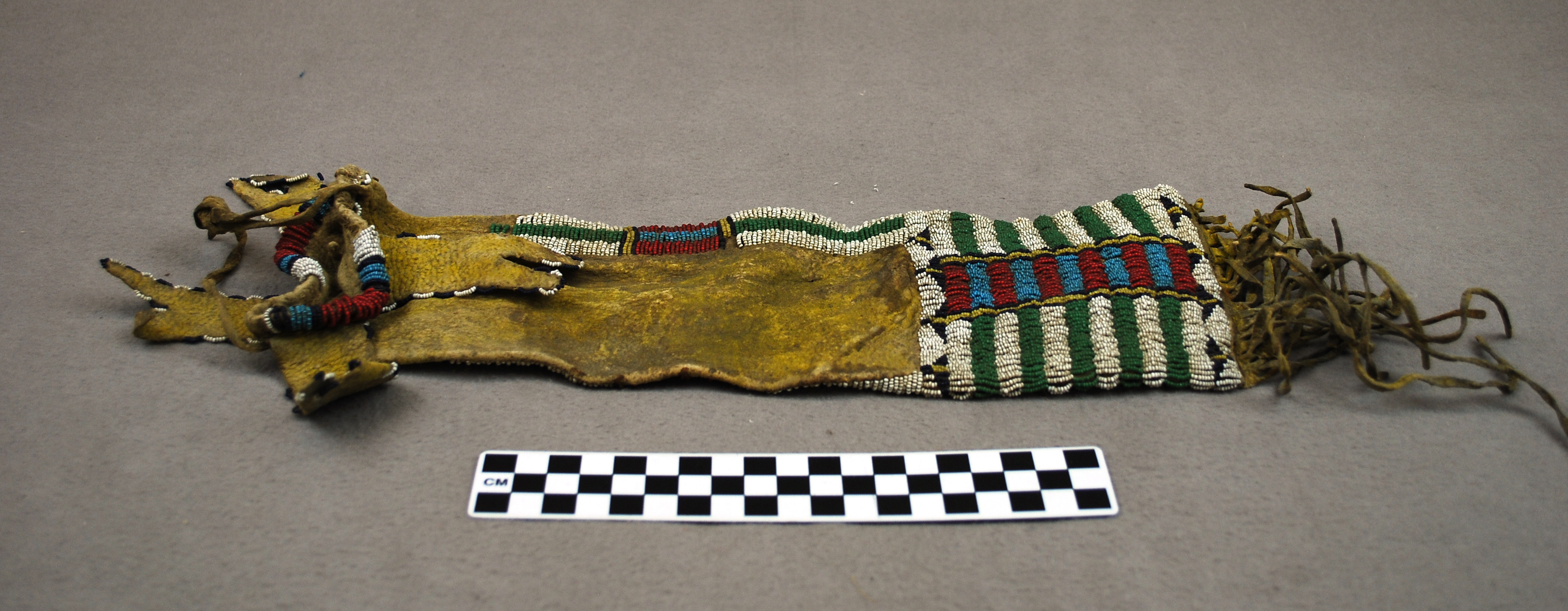Museums often receive objects with little known history. This beaded buckskin pouch was given as a gift to the Institute of Texan cultures many years ago without any information on its origin. However, the style of beadwork and materials used indicate that it likely came from a Plains Indian tribe. These types of items are found in many museum collections. The Great Plains covers a wide range of the United States, as can be seen in the map to the left. The area designated in red highlights the Great Plains where many Native American tribes resided and are more broadly referred to as the Plains Indians (or Plains Tribes).
Because these tribes lived in the same environment, they adopted similar lifestyles and made similar daily life items. It is not uncommon for museums to struggle with identifying a specific tribe, for all their objects. By using the term Plains Indians, the museum is able to identify an item’s regional origin without having to know the exact tribal affiliation. Some of the struggle comes from the history of trade amongst the tribes across the Great Plains. This beaded pouch has a beaded design on the lower third of the bag and is made of an animal hide. This could describe the majority of beaded bags, not only amongst the Plains Indians, but most tribes across the United States. Uniformity in style, shape, color or technique, indicates trade activity and a shared knowledge amongst various tribes on how to craft beaded goods. Yet, sometimes a particular kind of bead, design, animal hide, or stitching can also help to identify a tribe. If a particular type of bead, animal hide or stitching is repeated in many craft goods of one tribe but is not consistent amongst the other tribes, you can use that feature to determine which tribe made the item. During the 1950s Orvoell Gallagher and Louis Powell wrote a paper entitled, Time Perspective in Plains Indian Beaded Art (1953). The paper discussed the struggle museums have in identifying Plains Indian craft goods. They pointed to the same issue of trade. If all the tribes are trading with one another it makes it much harder to find anything unique. Their paper called for criteria to be built on what to look for in identifying Plains Indian craft goods. The criteria would help guide other museums when identifying Native American products.
Beaded pouches have great potential to help identify tribal origin. The animal hide that many Native American pouches are made of can be the first clue. One of the first things to look for is what type of animal skin was used. If a tribe didn’t have access to that animal, they either received the hide in trade, or it is not theirs. Most tribes used animal hides for pouches, clothes, blankets, shelter and even drums. The process to prepare the skin of an animal for use is called ‘tanning the hide’. Using every part of an animal after hunting was a common practice, nothing was to be wasted. The women of the tribe often collected the skin and brain of the animal after the meat and other organs were taken. The process of transforming the skin into leather, or ‘tanning’ it, requires many steps. The hair, flesh and membrane would need to be scraped away, leaving only bare skin. Then a mixture of animal fats and/or brain would be rubbed into the skin, followed by soaking and then stretching the hide. During the stretching and drying is when they could change the color of the hide by smoking it or adding pigment. While the overall steps of tanning a hide is consistent amongst many tribes, the hide color choice could certainly be an identifying characteristic.
Another aspect of the beaded pouch that could be used to identify tribal origin is the beadwork itself. This particular beaded pouch uses small decorative beads, sometimes called seed beads. The glass seed beads are significant as they are evidence that the item was made after trade contact with European settlers was established. Beads can thus help identify the date of a craft good as well. The seed beads first became very common to Plains Indians around the mid-1800s, this is not to suggest that the pouch was certainly made then, but that it is unlikely that it could have been made before. The color of the beads and the design they create on the bag are also potential identifying marks.
Bags similar to the one in the UTSA Institute of Texan Cultures collections are known from the Ute tribe, Sioux tribe and Southern Cheyenne. All of these are examples of beaded bags from Plains Indian tribes. All of the bags are rectangular and taper slightly up to the opening of the bag. There is also fringe and beadwork on each bag, and each uses the lazy stitch technique to apply the beads. This technique is anything but lazy. Instead of sewing on one bead at a time, you thread several beads to stitch on all at once. A time consuming task especially, when trying to create a pattern or design. The Ute example also has a four-flap opening with tie off at the top. Each is similar in style and design to the beaded pouch we are discussing, however, based on the bead design and the mouth flaps we believe the ITC pouch is a Cheyenne bag.
There are many other characteristics of craft goods that we can use to identify the tribe they belonged to. Material, bead design and how the item was made are just some of the first things to consider. Museums and archaeologists have collaborated over time to build a wealth of knowledge to aid in the exploration and identification of objects. Each object has a story and history waiting to be told.
